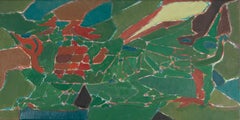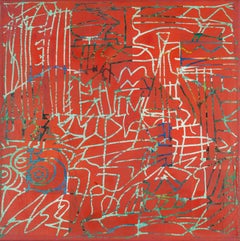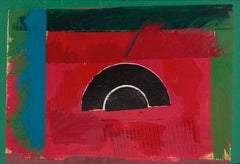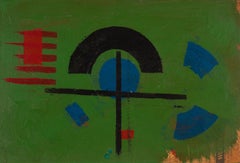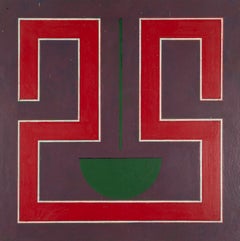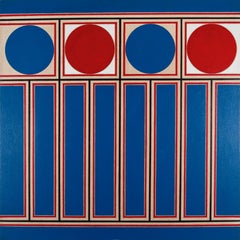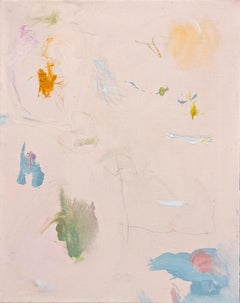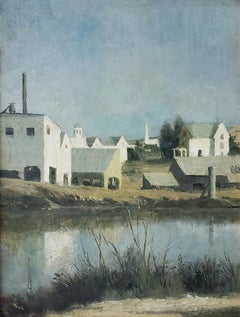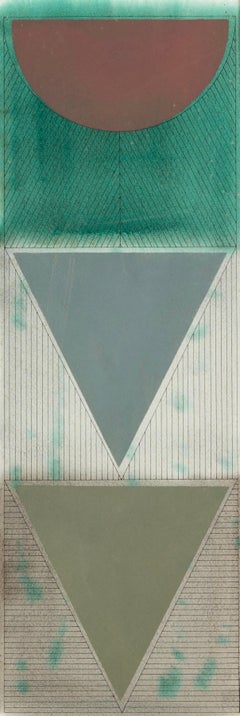Gordon House Paintings
British, b. 1932
The Guardian wrote of Gordon House, upon his death in 2004:
Many of the works made during his last years by the painter and graphic designer Gordon House, who has died aged 71, referred back to his birthplace in the Swansea valley. He spent his earliest years in the steel town of Pontardawe. In Tin-pan Valley, the memoir he published earlier this year, he recalled "the clamour of steel mills ... the tinplate works and pithead gear" and "dynamite blasting as coal seams were struck higher up the valley".
Unemployment and the depression of the 1930s led Gordon's parents to take him from the valleys of south Wales to the order and designed coherence of Letchworth, "Hertfordshire's first garden city". After leaving school at 14, he went to study, first, at Luton School of Art. For a while after that, he worked in a hospital, before, with the aid of a scholarship, moving on to St Albans School of Art.
By 1961, Gordon had become established among a new generation of artists as an independently minded and adventurous painter and designer. The previous year, he had shown his large, bold, hard-edged canvasses at the important London "Situation" exhibition of large-scale abstract painting, and had designed the catalogue for that exhibition.
As the 1960s moved on, Gordon designed for the pop world. He worked for the Beatles, designing their White album and the back of the Sergeant Pepper album, for which his longtime friend Peter Blake designed the front. Later, he designed Wings' first album. He delighted in the creative energy of others, and so could respond to the talents of musicians and artists alike.
Gordon made paintings throughout his life as a designer. During the 1960s and 70s, his canvasses and prints reflected the dramatic tensions of his graphic design; by the 1980s, Wales had become his constant subject matter. The surface, texture and colour of his paintings softened. No doubt, he needed to pay homage to the places and the people who had shaped him, just as he always paid homage to the artists for whom he designed.
His canvasses reduced in size, becoming palm-of-the-hand landscapes. He spent much time in Wales and, in his final years, he used his brush to walk a path through memories of collieries, valleys, smoking stacks, rows of cottages and the people who had first nurtured him.to
7
6
3
4
Overall Width
to
Overall Height
to
15
5
3
3
1
10
6
4
6
4
3
2
2
1
1
1
1
1
1
1
1
1
1
1
1
1
1
1
20
12
12
12
5
38
783
709
702
697
10
20
Artist: Gordon House
The Dragon's Wing, 1990 - Bold Green Abstract Painting with Red and Blue
By Gordon House
Located in Kingsclere, GB
Gordon House was born in 1932 in Pontardawe, South Wales. Early exposure to art on trips to the Glynn Vivian Art Gallery as a young boy inspired House towards creative endeavors and ...
Category
1990s Gordon House Paintings
Materials
Canvas, Oil
Untitled, circa 2001 - Abstract Oil Painting over Paper Collage
By Gordon House
Located in Kingsclere, GB
Gordon House was born in 1932 in Pontardawe, South Wales. Early exposure to art on trips to the Glynn Vivian Art Gallery as a young boy inspired House towards creative endeavors and ...
Category
Early 2000s Gordon House Paintings
Materials
Canvas, Oil, Magazine Paper
Inner and Outer Arc, 1970 - Geometric Abstract Painting
By Gordon House
Located in Kingsclere, GB
Gordon House was born in 1932 in Pontardawe, South Wales. Early exposure to art on trips to the Glynn Vivian Art Gallery as a young boy inspired House towards creative endeavors and ...
Category
1970s Gordon House Paintings
Materials
Oil, Board
Arc in Register, 1970 - Oil, Bold Abstract Painting
By Gordon House
Located in Kingsclere, GB
Gordon House was born in 1932 in Pontardawe, South Wales. Early exposure to art on trips to the Glynn Vivian Art Gallery as a young boy inspired House towards creative endeavors and at the age of fourteen he was awarded a grant to enter art school which he accepted. From 1947 to 1950 he studied at Luton School of Art, Bedfordshire, and St. Albans School of Art, Hertfordshire. House's contemporaries included Richard Smith and John Plumb with whom he remained close. During the early fifties, after finishing art school, House began work as assistant to the ecclesiastical sculptor Theodore Kern. He also spent time at an advertising studio where he honed his burgeoning skills in typography and graphic design. In 1952 House was offered the position of designer for Imperial Chemical Industries Plastics Division where he stayed until 1959. This was followed by two years spent as graphic designer for the Kynoch Press in London. In 1961 House set out on his own as a self-employed designer and typographer. Initially this was supplemented by part-time teaching at art schools in and around London but by 1964 House was able to devote himself entirely to his design work which freed up valuable time to concentrate on his own artistic output in the studio.
In the late fifties, informed by the new art emerging from America and that of his contemporaries in England, House began to create large-scale abstract works which he was invited to show in 1959 at Dennis Bowen's legendary New Vision Centre in Marble Arch.
House was an active participant in the vibrant London art scene of the sixties, regularly attending lectures, exhibitions and discussions. In 1960 he exhibited in 'Situation' the key abstract exhibition of the decade held at the RBA Galleries. Other participating artists included Robyn Denny, Bernard and Harold Cohen, Gillian Ayres, John Hoyland, Richard Smith and William Turnbull among others. These artists, united by a common admiration for American Abstract Expressionism, were frustrated by the lack of exposure given to large-scale abstract works in commercial galleries so they organised their own exhibition. The name was derived from the participants' idea that an abstract painting that occupied the whole field of vision would involve the spectator in an 'event' or 'situation'. This exhibition was followed by 'New London Situation' in 1961 and a nationwide touring Arts Council presentation in recognition of the significance of the two earlier shows.
In 1961 House began producing his first prints at the Kelpra Studio, run by Chris and Rose Prater, where he made the earliest fine art screenprint ever to be produced in Britain. Artists such as Paolozzi and Hamilton followed in his footsteps and together they started a printmaking revolution in Britain. They cemented the medium of the screenprint in the world of fine art as opposed to the commercial sphere and secured the reputation of Kelpra in the process. Later, together with Cliff White, House set up the White Ink (Ltd.) print studio in London, where he produced etchings and wood engravings on a series of magnificent antique printing presses...
Category
20th Century Gordon House Paintings
Materials
Canvas, Oil
Red Forms with Small Green Segment - Bold 1960s Abstract Oil Painting, Sixties
By Gordon House
Located in Kingsclere, GB
Gordon House was born in 1932 in Pontardawe, South Wales. Early exposure to art on trips to the Glynn Vivian Art Gallery as a young boy inspired House towards creative endeavors and at the age of fourteen he was awarded a grant to enter art school which he accepted. From 1947 to 1950 he studied at Luton School of Art, Bedfordshire, and St. Albans School of Art, Hertfordshire. House's contemporaries included Richard Smith and John Plumb with whom he remained close. During the early fifties, after finishing art school, House began work as assistant to the ecclesiastical sculptor Theodore Kern. He also spent time at an advertising studio where he honed his burgeoning skills in typography and graphic design. In 1952 House was offered the position of designer for Imperial Chemical Industries Plastics Division where he stayed until 1959. This was followed by two years spent as graphic designer for the Kynoch Press in London. In 1961 House set out on his own as a self-employed designer and typographer. Initially this was supplemented by part-time teaching at art schools in and around London but by 1964 House was able to devote himself entirely to his design work which freed up valuable time to concentrate on his own artistic output in the studio.
In the late fifties, informed by the new art emerging from America and that of his contemporaries in England, House began to create large-scale abstract works which he was invited to show in 1959 at Dennis Bowen's legendary New Vision Centre in Marble Arch.
House was an active participant in the vibrant London art scene of the sixties, regularly attending lectures, exhibitions and discussions. In 1960 he exhibited in 'Situation' the key abstract exhibition of the decade held at the RBA Galleries. Other participating artists included Robyn Denny, Bernard and Harold Cohen, Gillian Ayres, John Hoyland, Richard Smith and William Turnbull among others. These artists, united by a common admiration for American Abstract Expressionism, were frustrated by the lack of exposure given to large-scale abstract works in commercial galleries so they organised their own exhibition. The name was derived from the participants' idea that an abstract painting that occupied the whole field of vision would involve the spectator in an 'event' or 'situation'. This exhibition was followed by 'New London Situation' in 1961 and a nationwide touring Arts Council presentation in recognition of the significance of the two earlier shows.
In 1961 House began producing his first prints at the Kelpra Studio, run by Chris and Rose Prater, where he made the earliest fine art screenprint ever to be produced in Britain. Artists such as Paolozzi and Hamilton followed in his footsteps and together they started a printmaking revolution in Britain. They cemented the medium of the screenprint in the world of fine art as opposed to the commercial sphere and secured the reputation of Kelpra in the process. Later, together with Cliff White, House set up the White Ink (Ltd.) print studio in London, where he produced etchings and wood engravings on a series of magnificent antique printing presses...
Category
20th Century Gordon House Paintings
Materials
Oil, Board
Blue/Red Ornament Frieze II, 1976-77 - Large Bold, Bright Abstract Painting
By Gordon House
Located in Kingsclere, GB
Gordon House 1932-2004
Blue/Red Ornament Frieze II, 1976-1977
with Artist's label attached to the stretcher bar
acrylic on canvas
91 x 91 cm
35 7/8 x 35 7/8 in
Gordon House was born in 1932 in Pontardawe, South Wales. Early exposure to art on trips to the Glynn Vivian Art Gallery as a young boy inspired House towards creative endeavors and at the age of fourteen he was awarded a grant to enter art school which he accepted. From 1947 to 1950 he studied at Luton School of Art, Bedfordshire, and St. Albans School of Art, Hertfordshire. House's contemporaries included Richard Smith and John Plumb with whom he remained close. During the early fifties, after finishing art school, House began work as assistant to the ecclesiastical sculptor Theodore Kern. He also spent time at an advertising studio where he honed his burgeoning skills in typography and graphic design. In 1952 House was offered the position of designer for Imperial Chemical Industries Plastics Division where he stayed until 1959. This was followed by two years spent as graphic designer for the Kynoch Press in London. In 1961 House set out on his own as a self-employed designer and typographer. Initially this was supplemented by part-time teaching at art schools in and around London but by 1964 House was able to devote himself entirely to his design work which freed up valuable time to concentrate on his own artistic output in the studio.
In the late fifties, informed by the new art emerging from America and that of his contemporaries in England, House began to create large-scale abstract works which he was invited to show in 1959 at Dennis Bowen's legendary New Vision Centre in Marble Arch.
House was an active participant in the vibrant London art scene of the sixties, regularly attending lectures, exhibitions and discussions. In 1960 he exhibited in 'Situation' the key abstract exhibition of the decade held at the RBA Galleries. Other participating artists included Robyn Denny, Bernard and Harold Cohen, Gillian Ayres, John Hoyland, Richard Smith and William Turnbull among others. These artists, united by a common admiration for American Abstract Expressionism, were frustrated by the lack of exposure given to large-scale abstract works in commercial galleries so they organised their own exhibition. The name was derived from the participants' idea that an abstract painting that occupied the whole field of vision would involve the spectator in an 'event' or 'situation'. This exhibition was followed by 'New London Situation' in 1961 and a nationwide touring Arts Council presentation in recognition of the significance of the two earlier shows.
In 1961 House began producing his first prints at the Kelpra Studio, run by Chris and Rose Prater, where he made the earliest fine art screenprint ever to be produced in Britain. Artists such as Paolozzi and Hamilton followed in his footsteps and together they started a printmaking revolution in Britain. They cemented the medium of the screenprint in the world of fine art as opposed to the commercial sphere and secured the reputation of Kelpra in the process. Later, together with Cliff White, House set up the White Ink (Ltd.) print studio in London, where he produced etchings and wood engravings on a series of magnificent antique printing...
Category
20th Century Abstract Geometric Gordon House Paintings
Materials
Canvas, Acrylic
Scooped Palette - Large Green Painting with Bold Geometric Shapes, Abstracted
By Gordon House
Located in Kingsclere, GB
Gordon House was born in 1932 in Pontardawe, South Wales. Early exposure to art on trips to the Glynn Vivian Art Gallery as a young boy inspired House towards creative endeavors and ...
Category
21st Century and Contemporary Gordon House Paintings
Materials
Canvas, Oil
Highway - Bold Abstract Painting with Red, Blue and Green
By Gordon House
Located in Kingsclere, GB
Gordon House was born in 1932 in Pontardawe, South Wales. Early exposure to art on trips to the Glynn Vivian Art Gallery as a young boy inspired House towards creative endeavors and ...
Category
1990s Gordon House Paintings
Materials
Canvas, Oil
Grey/Pink, from Study for Larger Tri Motif Series, 1977 - Gouache, Watercolour
By Gordon House
Located in Kingsclere, GB
Gordon House was born in 1932 in Pontardawe, South Wales. Early exposure to art on trips to the Glynn Vivian Art Gallery as a young boy inspired House towards creative endeavors and ...
Category
20th Century Gordon House Paintings
Materials
Ink, Watercolor, Gouache
Red/Green, from Study for Larger Tri Motif Series, 1977 - Gouache, Watercolour
By Gordon House
Located in Kingsclere, GB
Gordon House was born in 1932 in Pontardawe, South Wales. Early exposure to art on trips to the Glynn Vivian Art Gallery as a young boy inspired House towards creative endeavors and at the age of fourteen he was awarded a grant to enter art school which he accepted. From 1947 to 1950 he studied at Luton School of Art, Bedfordshire, and St. Albans School of Art, Hertfordshire. House's contemporaries included Richard Smith and John Plumb with whom he remained close. During the early fifties, after finishing art school, House began work as assistant to the ecclesiastical sculptor Theodore Kern. He also spent time at an advertising studio where he honed his burgeoning skills in typography and graphic design. In 1952 House was offered the position of designer for Imperial Chemical Industries Plastics Division where he stayed until 1959. This was followed by two years spent as graphic designer for the Kynoch Press in London. In 1961 House set out on his own as a self-employed designer and typographer. Initially this was supplemented by part-time teaching at art schools in and around London but by 1964 House was able to devote himself entirely to his design work which freed up valuable time to concentrate on his own artistic output in the studio.
In the late fifties, informed by the new art emerging from America and that of his contemporaries in England, House began to create large-scale abstract works which he was invited to show in 1959 at Dennis Bowen's legendary New Vision Centre in Marble Arch.
House was an active participant in the vibrant London art scene of the sixties, regularly attending lectures, exhibitions and discussions. In 1960 he exhibited in 'Situation' the key abstract exhibition of the decade held at the RBA Galleries. Other participating artists included Robyn Denny, Bernard and Harold Cohen, Gillian Ayres, John Hoyland, Richard Smith and William Turnbull among others. These artists, united by a common admiration for American Abstract Expressionism, were frustrated by the lack of exposure given to large-scale abstract works in commercial galleries so they organised their own exhibition. The name was derived from the participants' idea that an abstract painting that occupied the whole field of vision would involve the spectator in an 'event' or 'situation'. This exhibition was followed by 'New London Situation' in 1961 and a nationwide touring Arts Council presentation in recognition of the significance of the two earlier shows.
In 1961 House began producing his first prints at the Kelpra Studio, run by Chris and Rose Prater, where he made the earliest fine art screenprint ever to be produced in Britain. Artists such as Paolozzi and Hamilton followed in his footsteps and together they started a printmaking revolution in Britain. They cemented the medium of the screenprint in the world of fine art as opposed to the commercial sphere and secured the reputation of Kelpra in the process. Later, together with Cliff White, House set up the White Ink (Ltd.) print studio in London, where he produced etchings and wood engravings on a series of magnificent antique printing presses...
Category
20th Century Gordon House Paintings
Materials
Ink, Watercolor, Gouache
Untitled - Large Pink Painting over Paper Collage
By Gordon House
Located in Kingsclere, GB
Gordon House was born in 1932 in Pontardawe, South Wales. Early exposure to art on trips to the Glynn Vivian Art Gallery as a young boy inspired House towards creative endeavors and ...
Category
Early 2000s Gordon House Paintings
Materials
Canvas, Oil, Magazine Paper
Mitred Matrix (Red), 1968 - Bold 1960s Abstract Oil Painting, Geometric Forms
By Gordon House
Located in Kingsclere, GB
Gordon House 1932-2004
Mitred Matrix (Red), 1968
oil on canvas
152.5 x 152.5 cm
60 x 60 in
unsigned, though from the Estate of the Artist
Gordon House was born in 1932 in Pontardaw...
Category
20th Century Gordon House Paintings
Materials
Canvas, Oil
Double Red Triangle, 1974 - Geometric Abstract Acrylic Painting
By Gordon House
Located in Kingsclere, GB
Gordon House was born in 1932 in Pontardawe, South Wales. Early exposure to art on trips to the Glynn Vivian Art Gallery as a young boy inspired House towards creative endeavors and ...
Category
20th Century Gordon House Paintings
Materials
Canvas, Acrylic
Untitled - Green Abstract Painting with Red and Blue
By Gordon House
Located in Kingsclere, GB
Gordon House was born in 1932 in Pontardawe, South Wales. Early exposure to art on trips to the Glynn Vivian Art Gallery as a young boy inspired House towards creative endeavors and ...
Category
1990s Gordon House Paintings
Materials
Canvas, Oil
Untitled - Large Blue Painting with Blue and Red, Bold Geometric Shapes
By Gordon House
Located in Kingsclere, GB
Gordon House was born in 1932 in Pontardawe, South Wales. Early exposure to art on trips to the Glynn Vivian Art Gallery as a young boy inspired House towards creative endeavors and ...
Category
21st Century and Contemporary Gordon House Paintings
Materials
Canvas, Oil
Late Path II (Antibes) - Abstract Painting with Ochre and Blues
By Gordon House
Located in Kingsclere, GB
Gordon House was born in 1932 in Pontardawe, South Wales. Early exposure to art on trips to the Glynn Vivian Art Gallery as a young boy inspired House towards creative endeavors and ...
Category
Early 2000s Gordon House Paintings
Materials
Oil, Board
Ochre, from Study for Larger Tri Motif Series, 1977 - Pale Colours
By Gordon House
Located in Kingsclere, GB
Gordon House was born in 1932 in Pontardawe, South Wales. Early exposure to art on trips to the Glynn Vivian Art Gallery as a young boy inspired House towards creative endeavors and ...
Category
1970s Gordon House Paintings
Materials
Ink, Watercolor, Gouache
Red/Green Ornament Frieze I - Bold Green and Red Shapes, Abstract Oil Painting
By Gordon House
Located in Kingsclere, GB
Gordon House 1932-2004
Red/Green Ornament Frieze I, 1976-1977
signed and dated on the canvas overlap
acrylic on canvas
91 x 91 cm
35 7/8 x 35 7/8 in
Gordon House was born in 1932 in Pontardawe, South Wales. Early exposure to art on trips to the Glynn Vivian Art Gallery as a young boy inspired House towards creative endeavors and at the age of fourteen he was awarded a grant to enter art school which he accepted. From 1947 to 1950 he studied at Luton School of Art, Bedfordshire, and St. Albans School of Art, Hertfordshire. House's contemporaries included Richard Smith and John Plumb with whom he remained close. During the early fifties, after finishing art school, House began work as assistant to the ecclesiastical sculptor Theodore Kern. He also spent time at an advertising studio where he honed his burgeoning skills in typography and graphic design. In 1952 House was offered the position of designer for Imperial Chemical Industries Plastics Division where he stayed until 1959. This was followed by two years spent as graphic designer for the Kynoch Press in London. In 1961 House set out on his own as a self-employed designer and typographer. Initially this was supplemented by part-time teaching at art schools in and around London but by 1964 House was able to devote himself entirely to his design work which freed up valuable time to concentrate on his own artistic output in the studio.
In the late fifties, informed by the new art emerging from America and that of his contemporaries in England, House began to create large-scale abstract works which he was invited to show in 1959 at Dennis Bowen's legendary New Vision Centre in Marble Arch.
House was an active participant in the vibrant London art scene of the sixties, regularly attending lectures, exhibitions and discussions. In 1960 he exhibited in 'Situation' the key abstract exhibition of the decade held at the RBA Galleries. Other participating artists included Robyn Denny, Bernard and Harold Cohen, Gillian Ayres, John Hoyland, Richard Smith and William Turnbull among others. These artists, united by a common admiration for American Abstract Expressionism, were frustrated by the lack of exposure given to large-scale abstract works in commercial galleries so they organised their own exhibition. The name was derived from the participants' idea that an abstract painting that occupied the whole field of vision would involve the spectator in an 'event' or 'situation'. This exhibition was followed by 'New London Situation' in 1961 and a nationwide touring Arts Council presentation in recognition of the significance of the two earlier shows.
In 1961 House began producing his first prints at the Kelpra Studio, run by Chris and Rose Prater, where he made the earliest fine art screenprint ever to be produced in Britain. Artists such as Paolozzi and Hamilton followed in his footsteps and together they started a printmaking revolution in Britain. They cemented the medium of the screenprint in the world of fine art as opposed to the commercial sphere and secured the reputation of Kelpra in the process. Later, together with Cliff White, House set up the White Ink (Ltd.) print studio in London, where he produced etchings and wood engravings on a series of magnificent antique printing...
Category
1970s Gordon House Paintings
Materials
Canvas, Acrylic
Grey, from Study for Larger Tri Motif Series, c. 1977 - Gouache and Watercolour
By Gordon House
Located in Kingsclere, GB
Gordon House was born in 1932 in Pontardawe, South Wales. Early exposure to art on trips to the Glynn Vivian Art Gallery as a young boy inspired House towards creative endeavors and at the age of fourteen he was awarded a grant to enter art school which he accepted. From 1947 to 1950 he studied at Luton School of Art, Bedfordshire, and St. Albans School of Art, Hertfordshire. House's contemporaries included Richard Smith and John Plumb with whom he remained close. During the early fifties, after finishing art school, House began work as assistant to the ecclesiastical sculptor Theodore Kern. He also spent time at an advertising studio where he honed his burgeoning skills in typography and graphic design. In 1952 House was offered the position of designer for Imperial Chemical Industries Plastics Division where he stayed until 1959. This was followed by two years spent as graphic designer for the Kynoch Press in London. In 1961 House set out on his own as a self-employed designer and typographer. Initially this was supplemented by part-time teaching at art schools in and around London but by 1964 House was able to devote himself entirely to his design work which freed up valuable time to concentrate on his own artistic output in the studio.
In the late fifties, informed by the new art emerging from America and that of his contemporaries in England, House began to create large-scale abstract works which he was invited to show in 1959 at Dennis Bowen's legendary New Vision Centre in Marble Arch.
House was an active participant in the vibrant London art scene of the sixties, regularly attending lectures, exhibitions and discussions. In 1960 he exhibited in 'Situation' the key abstract exhibition of the decade held at the RBA Galleries. Other participating artists included Robyn Denny, Bernard and Harold Cohen, Gillian Ayres, John Hoyland, Richard Smith and William Turnbull among others. These artists, united by a common admiration for American Abstract Expressionism, were frustrated by the lack of exposure given to large-scale abstract works in commercial galleries so they organised their own exhibition. The name was derived from the participants' idea that an abstract painting that occupied the whole field of vision would involve the spectator in an 'event' or 'situation'. This exhibition was followed by 'New London Situation' in 1961 and a nationwide touring Arts Council presentation in recognition of the significance of the two earlier shows.
In 1961 House began producing his first prints at the Kelpra Studio, run by Chris and Rose Prater, where he made the earliest fine art screenprint ever to be produced in Britain. Artists such as Paolozzi and Hamilton followed in his footsteps and together they started a printmaking revolution in Britain. They cemented the medium of the screenprint in the world of fine art as opposed to the commercial sphere and secured the reputation of Kelpra in the process. Later, together with Cliff White, House set up the White Ink (Ltd.) print studio in London, where he produced etchings and wood engravings on a series of magnificent antique printing presses...
Category
20th Century Gordon House Paintings
Materials
Ink, Watercolor, Gouache
III, from Tri Motifs, 1977 - Bold Shapes, Orange, Green, Gouache and Watercolour
By Gordon House
Located in Kingsclere, GB
Gordon House was born in 1932 in Pontardawe, South Wales. Early exposure to art on trips to the Glynn Vivian Art Gallery as a young boy inspired House towards creative endeavors and ...
Category
20th Century Gordon House Paintings
Materials
Ink, Watercolor, Gouache
Related Items
"Say it (Over & Over Again)" Contemporary Pastel Abstract Expressionist Painting
Located in Houston, TX
Exhibited in "Benji Stiles: A Human Day" at Reeves Art + Design.
In “A Human Day,” a solo show dedicated to the work of contemporary multidisciplinary artist Benji Stiles, we explor...
Category
2010s Contemporary Gordon House Paintings
Materials
Canvas, Oil, Gesso, Graphite
$400
H 20 in W 16 in D 0.88 in
Vermont Barns - Neutral Monochromatic Study in Grays
By John Koch
Located in Miami, FL
Understated town-scape in grays and muted blues. It's a painting that looks better as you get closer to it.
Koch brings the same serene intimacy to an outdoor scene as his interiors....
Category
1950s American Realist Gordon House Paintings
Materials
Oil, Board
“Blue Landscape – Original Abstract Painting on Paper by Marilina Marchica
By Marilina Marchica
Located in Agrigento, AG
Description:
Blue Landscape is an original abstract painting by Italian artist Marilina Marchica, created in 2025 using pure pigment on Paper. The artwork measures 54x 50 cm .
This p...
Category
2010s Contemporary Gordon House Paintings
Materials
Cotton Canvas, Oil
$1,246 Sale Price
20% Off
H 21.26 in W 19.69 in D 0.79 in
Original-Sunshine Factory 2025-British Awarded Artist-Abstract Oil on canvas
Located in London, GB
Shizico Yi documented the early spring light in the sky over her garden, a welcoming sight after a long cold winter.
“Sunshine Factory 2025 is a genuine and authentic piece of work ...
Category
2010s Abstract Gordon House Paintings
Materials
Gesso, Canvas, Oil, Acrylic
$714
H 19.69 in W 15.75 in D 0.6 in
Light eternal - Dreamy abstract floral landscape painting
By Jennifer L. Baker
Located in Silverthorne, CO
"Light eternal" is a dreamy abstract floral landscape painting, inspired by the unfurling of the yellow rose, light pouring out into the world. It is made in an ethereal palette of y...
Category
21st Century and Contemporary Contemporary Gordon House Paintings
Materials
Oil, Canvas
$1,992 Sale Price
20% Off
H 31.5 in W 31.5 in D 0.79 in
Original Abstract Mixed Media Painting
By William Finlayson Jr.
Located in West Palm Beach, FL
Born in Tallahasee Fl, William started his artistic career as a color consultant for his family's Design and Painting company that took on constant projects of custom painted interiors and decorating. This work of 20 yrs lead him to his fascination with textiles and paint, along with custom furniture. After creating and selling dozens of unique pieces of furniture, here began his transition from wall, to wood on furniture, to canvas. Painting on canvas was the culmination of his creative outlet. William feels that his lack of formal training in Fine Art has afforded him a freedom to paint what he envisions and feels, rather than conform to specific style or genre that he feels is limiting Inspired by hard edge abstraction and color field art such as Kenneth Noland, Joseph Albers, Gene Davis, Frank Stella, Anne Truitt, Imi knobel...
Category
21st Century and Contemporary Modern Gordon House Paintings
Materials
Acrylic, Paper, Magazine Paper
Landscape , Contemporary Paint on Cotton Canvas , Art By Marilina Marchica
By Marilina Marchica
Located in Agrigento, AG
Title: Landscape
Year: 2024
Technique: mixed media on Cotton Canvas
100x105 cm
Description:
This original work by Marilina Marchica explores the relationship between man, nature...
Category
2010s Contemporary Gordon House Paintings
Materials
Enamel
$3,067
H 41.34 in W 39.38 in D 0.99 in
Abstract, Signed Oil on Board Painting by John F. Leonard
Located in Long Island City, NY
Abstract (57)
John F. Leonard
American (1921–1987)
Date: 1977
Oil on Board, signed l.r.
Size: 16 in. x 20 in. (40.64 cm x 50.8 cm)
Frame Size: 18.5 x 22.5 inches
Category
1970s Abstract Gordon House Paintings
Materials
Oil, Board
$6,000
H 18.5 in W 22.5 in
'Mid-century Abstract', NYMoMA, Paris, XXXII Venice Biennale, MALI, Lima, Peru
By Emilio Rodríguez Larraín
Located in Santa Cruz, CA
'Midcentury Biomorphic Abstract' by Emilio Rodríguez Larraín, 1964.
NYMoMA, Paris, XXXII Venice Biennale, Museo de Arte de Lima, Lima, Peru
-----
Signed, lower right, 'E.R. Larrain' for Emilio Rodríguez Larraín (Peruvian, 1928-2015), and inscribed 'Roma, Nov 1963, Enero 1964'. (Rome, Nov 1963-January 1964). Verso titled, "L'Homme C'est Sujet à Errer" (Man Tends to Wander), and bearing the artist's self-portrait in india ink and wash.
Exhibited: XXXII Venice Biennale, 1964. (original exhibition label verso)
Previously with Staempfli Galleries, New York. This painting is registered in the Archives of American Art as 'Staempfli Gallery, inventory #775'.
A monumental and historically distinguished work by this groundbreaking Peruvian Modernist who drew inspiration from Peruvian indigenous and pre-colonial culture. The paintings of Emilio Rodríguez Larraín are held in the permanent collections of museums worldwide including the Musée de la Ville de Paris, Peru's Museo de Arte de Lima and the Museum of Modern Art in New York. This painting was selected by the Peruvian Government for exhibition at the XXXII Venice Biennale in 1964 and is the largest single recorded work by the artist.
Emilio Rodríguez Larraín received his Bachelors of Architecture in 1949 from Peru's Universidad Nacional de Ingeniería and held his first solo exhibition in Lima after visiting Europe in 1950. In 1951, he returned to Europe in the company of the artists Alfredo Ruiz Rosas and Joaquín Roca Rey...
Category
1960s Abstract Gordon House Paintings
Materials
Fiberboard, Laid Paper, Oil
$38,500
H 67 in W 91 in D 2.75 in
Mid Century Antica Roma Figurative Abstract Collage
By James Coughlin
Located in Soquel, CA
Stunning mid century mixed media collage of Roman travel items and photos by James A. Couglin, a Berkeley Abstract Expressionist (American, 1929-1979), c.1966. Painted during his Par...
Category
1960s American Modern Gordon House Paintings
Materials
Paper, Acrylic, Permanent Marker, Magazine Paper
$1,580 Sale Price
20% Off
H 30.75 in W 28.5 in D 1 in
Astral Alignment with puzzled rabbits
Located in Kingston, WA
In this painting, I merged surrealism with metaphysical wonder, using oil to invite viewers on a cosmic journey. The puzzled rabbits symbolize curiosity beneath a futuristic celestia...
Category
2010s Surrealist Gordon House Paintings
Materials
Canvas, Oil
Impressionist Oil Painting Cardboard "The Symbiosis of Waterlilies and Lotus"
Located in VÉNISSIEUX, FR
This beautiful floral painting, "The Symbiosis of Waterlilies and Lotus", created by French artist Natalya Mougenot, is a tribute to the artistic legacy of Claude Monet. As an artist...
Category
2010s Abstract Impressionist Gordon House Paintings
Materials
Oil, Cardboard
Natalya Mougenot Impressionist Oil Painting Cardboard "The Symbiosis of Waterlilies and Lotus", 2023
$275
H 11.82 in W 9.85 in D 0.08 in
Previously Available Items
II, from Tri Motifs, 1977 - Bold Shapes, Blue, Red, Gouache and Watercolour
By Gordon House
Located in Kingsclere, GB
Gordon House was born in 1932 in Pontardawe, South Wales. Early exposure to art on trips to the Glynn Vivian Art Gallery as a young boy inspired House towards creative endeavors and at the age of fourteen he was awarded a grant to enter art school which he accepted. From 1947 to 1950 he studied at Luton School of Art, Bedfordshire, and St. Albans School of Art, Hertfordshire. House's contemporaries included Richard Smith and John Plumb with whom he remained close. During the early fifties, after finishing art school, House began work as assistant to the ecclesiastical sculptor Theodore Kern. He also spent time at an advertising studio where he honed his burgeoning skills in typography and graphic design. In 1952 House was offered the position of designer for Imperial Chemical Industries Plastics Division where he stayed until 1959. This was followed by two years spent as graphic designer for the Kynoch Press in London. In 1961 House set out on his own as a self-employed designer and typographer. Initially this was supplemented by part-time teaching at art schools in and around London but by 1964 House was able to devote himself entirely to his design work which freed up valuable time to concentrate on his own artistic output in the studio.
In the late fifties, informed by the new art emerging from America and that of his contemporaries in England, House began to create large-scale abstract works which he was invited to show in 1959 at Dennis Bowen's legendary New Vision Centre in Marble Arch.
House was an active participant in the vibrant London art scene of the sixties, regularly attending lectures, exhibitions and discussions. In 1960 he exhibited in 'Situation' the key abstract exhibition of the decade held at the RBA Galleries. Other participating artists included Robyn Denny, Bernard and Harold Cohen, Gillian Ayres, John Hoyland, Richard Smith and William Turnbull among others. These artists, united by a common admiration for American Abstract Expressionism, were frustrated by the lack of exposure given to large-scale abstract works in commercial galleries so they organised their own exhibition. The name was derived from the participants' idea that an abstract painting that occupied the whole field of vision would involve the spectator in an 'event' or 'situation'. This exhibition was followed by 'New London Situation' in 1961 and a nationwide touring Arts Council presentation in recognition of the significance of the two earlier shows.
In 1961 House began producing his first prints at the Kelpra Studio, run by Chris and Rose Prater, where he made the earliest fine art screenprint ever to be produced in Britain. Artists such as Paolozzi and Hamilton followed in his footsteps and together they started a printmaking revolution in Britain. They cemented the medium of the screenprint in the world of fine art as opposed to the commercial sphere and secured the reputation of Kelpra in the process. Later, together with Cliff White, House set up the White Ink (Ltd.) print studio in London, where he produced etchings and wood engravings on a series of magnificent antique printing presses...
Category
20th Century Gordon House Paintings
Materials
Watercolor, Gouache, Ink
I from Tri Motifs, 1977 - Bold Shapes, Green, Red, Gouache and Watercolour
By Gordon House
Located in Kingsclere, GB
Gordon House was born in 1932 in Pontardawe, South Wales. Early exposure to art on trips to the Glynn Vivian Art Gallery as a young boy inspired House towards creative endeavors and ...
Category
20th Century Gordon House Paintings
Materials
Ink, Watercolor, Gouache
Gordon House paintings for sale on 1stDibs.
Find a wide variety of authentic Gordon House paintings available for sale on 1stDibs. Customers who are interested in this artist might also find the work of Tobias Harrison, Lorna Holdcroft-Kirin, and Jo Beer.
